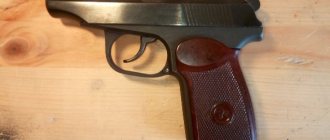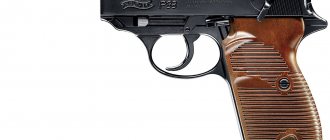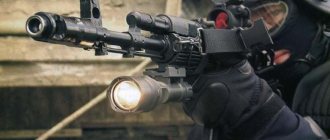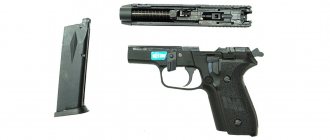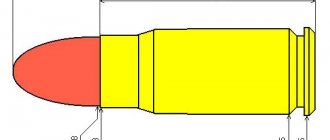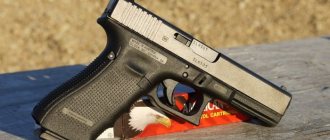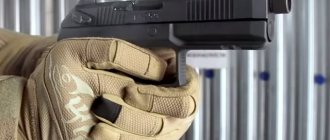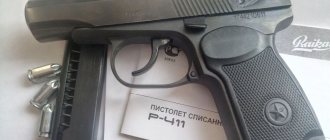The procedure for assembling the PM after complete disassembly
Reassemble the pistol after complete disassembly in the reverse order.
1. Assemble the store. Hold the magazine body in your left hand so that the magazine mounting lug is at the top and left;
With your right hand, insert the feeder into the magazine body. Insert the feeder spring into the magazine body with its bent end up and to the right and, pressing the spring with the thumb of your left hand (Fig. 25), with your right hand push the cover onto the curved ribs of the body so that the bent end of the spring pops into the hole in the cover. Rice. 25. Assembling the store.
2. Attach the ejector to the bolt (Fig. 26). Place the bolt on the table, and with your right hand insert the ejector spring with the bend (with the bend outward) into the bolt socket. Insert the ejector into the groove with the hook to the bolt cup and, holding it with the index finger of your left hand at the hook, press the oppression into the socket with the protrusion of rubbing the oppressors; simultaneously pressing the ejector towards the bend and down (turning around the hook), lower its heel into the bolt socket so that the head of the bend is located above the ledge of the ejector heel.
Rice.
26. Attaching the ejector to the bolt. 3. Attach the firing pin and safety to the bolt. Take the bolt in your left hand with the rear end facing you and insert the firing pin into the bolt channel so that its cut at the rear is facing the safety socket (to the left and down).
Using the thumb and forefinger of your right hand, insert the fuse into the bolt socket (Fig. 27) and turn its flag forward and down until it stops. Fig.27. Attaching the fuse to the shutter.
4. Attach the trigger to the frame. Holding the frame in your left hand, pull the trigger guard with your right and tilt it to the side; insert the trigger head into the window of the frame stand so that its trunnions fit into the trunnion sockets of the frame; put the trigger guard in place.
5. Attach the trigger rod with the cocking lever to the frame. Holding the frame in your left hand and moving the tail of the trigger back, insert the trigger rod pin into the hole in the trigger head and lower the rear end of the rod into the frame onto the back wall of the base of the handle.
Fig.28. Attaching the trigger to the frame.
6. Attach the trigger to the frame. Holding the frame by the base of the handle with your left hand and turning the trigger to the forward position, tilt the trigger head forward with your right hand, insert its trunnions into the trunnion sockets in the frame (Fig. 28) and turn the trigger head back.
7. Attach the mainspring to the frame. Place the gun on the palm of your left hand; turning the trigger forward and the cocking lever up, insert the feathers of the mainspring into the window of the frame with your right hand and put the spring with the hole on the boss of the base of the handle so that the wide feather of the mainspring is located in the recess of the trigger, and the narrow feather on the heel of the cocking lever (Fig. 29 ).
Fig.29. Attaching the mainspring to the frame.
Turn the pistol so that the back wall of the base of the handle is facing you, and, holding the mainspring by the magazine latch with the thumb of your left hand, and the front wall of the base of the handle with your index finger, put on the mainspring bolt with the thumb and forefinger of your right hand (Fig. 30).
Rice. 30. Securing the mainspring with a bolt.
Check that the mainspring is correctly positioned by lightly pressing the tail of the trigger. If the trigger is pulled back, then the spring is installed correctly.
8. Attach the handle to the handle base. Place the handle on the base of the handle and screw in the screw until it stops, then loosen the screw half a turn.
9. Attach the bolt stop and sear to the frame. Holding the frame in your left hand, insert the slide stop into the cutout of the frame with your right hand; take the sear so that the flat on its right trunnion is facing forward (that is, with the nose up); insert into the left trunnion socket of the frame (combined with the bolt stop hole) first the left sear pin (on which the spring is located), and then insert the right sear pin into the trunnion socket in the frame (Fig. 31).
Fig.31. Attaching the bolt stop and sear to the frame.
Turn the sear back. Using the rubbing protrusion, place the hook of the sear spring onto the bolt stop.
Note. It is prohibited to self-cock the hammer until it releases when the bolt is not attached to the frame.
10. Carry out further assembly as indicated above.
Recommendations
The basic recommendations for disassembling a Makarov pistol are identical to those for all types of weapons: All maintenance work should be performed only on a flat surface that does not allow loss of parts; it is also recommended to choose a surface whose color differs from the color of the pistol and components. Place the components and parts of the weapon carefully, in the order in which they were removed.
When disassembling and assembling a weapon, perform all actions with smooth movements, avoiding impacts, squeezing parts and using unnecessary force to remove mechanisms.
When assembling weapons, be sure to check the serial numbers of the product (in case of simultaneous assembly by several people).
Main options[edit]
CombatEdit
MP (sic!) produced in 1949 - pre-production release.
The first 30 pieces were manufactured at the Tula Arms Plant (one of them can be seen in the TsMVS exhibition; another is known as a gift to J.V. Stalin from Tula gunsmiths), another 5000 - at the Izhevsk Mechanical Plant No. 622. PM produced in 1953-54. — a small feature has been made: the automatic reset of the slide stop when a full magazine is attached has been removed, because the feature could lead to an accidental shot. PM produced after 1954 - the shape of the frame has been changed for greater ease of shooting with winter gloves. It is still produced today with minor changes. In the army it is gradually being replaced by the Yarygin pistol, in the FSO - by foreign-made pistols, in the Ministry of Internal Affairs it will remain the main pistol until the end of time for many, many years. PMM - modernized version of 1994. Designed for firing a reinforced cartridge in the same dimensions as the old one, therefore it is equipped with a massive bolt and Ivshin grooves in the chamber (the principle of operation is similar to the Revelli grooves, but has a different geometry). It is also almost always equipped with a double-row magazine with a capacity of 12 rounds (on paper there is also a version with a standard single-row magazine for 8 rounds - PMM-8, but, apparently, production did not go beyond several prototypes) Attention! The main defining feature of the PMM is the bolt, and not the two-row magazine. Calling any macaroid with a wide handle but a regular bolt “PMM” is stupid. Attention-2! Production of PMM has been discontinued
Yes exactly. Good night, sweet prince! And the ordinary PM is alive and well. Dear MTA, if you are describing a realistic setting with a time period after the second half of the 2000s and your policeman/military gets a brand new PMM instead of the old Makar, don’t write! Think about it! Such a pistol cannot be new, at most it can be left over from the old days
Attention-2! Production of PMM has been discontinued. Yes exactly
Good night, sweet prince! And the ordinary PM is alive and well. Dear MTA, if you are describing a realistic setting with a time period after the second half of the 2000s and your policeman/military gets a brand new PMM instead of the old Makar, don’t write! Think about it! Such a pistol cannot be new, at most it can be left over from the old days.
The PMM can fire the old cartridge: when firing it, the Ivshin grooves do not slow down the rollback; The PM, on the other hand, does not withstand firing with a reinforced cartridge.
Official, civil and commercial edit
- Izh-71
is a 9×17 caliber service pistol. A security guard might have one. There is an option with a double-stack magazine with a capacity of 10 rounds (according to the Weapons Law, 12 are not allowed). - Izh-70
(
IJ-70
) - export commercial versions. Available in 9×18 and 9×17 calibers, with single or double stack magazines, fixed and adjustable rear sights, standard blued finish or decorative finish. Capitalism, however! - Baikal-442
is an export modification developed specifically for the US market.
It comes standard with a double-stack, fully adjustable magazine, a side magazine release button and a reshaped trigger guard. After the United States introduced restrictions on the import of Izhmekh pistols, they forgot about it for a long time - but recently they remembered and certified it on the Russian market as the “ Baikal-442
” sports pistol (now in Cyrillic). - Izh-79
,
MP-79
,
MP-80
,
PM-T
,
P-M17T
- gas and traumatic pistols, one of the most popular on the Russian civilian weapons market. - MP-654K
is an air pistol produced by the Izhevsk Mechanical Plant. In cinema, he regularly passes for a combat PM from afar.
Partially based on PM design
- PB
(silent pistol) - a pistol with an integrated silencer designed by A. A. Deryagin. Contrary to popular misconception, the PB differs significantly from the PM in design and in no way can be called a “PM with a silencer.” However, the magazine and most of the trigger parts are unified with Makarov's. - PSS
“Vul” is much more similar to the PM structurally (and much less externally). Silent pistol chambered for a special closed-type cartridge SP-4.
Foreign productionedit
Under Soviet license, the PM was produced in the GDR (Pistole M), China (Type 59), Vietnam (K59) and in Bulgaria (Makarov Pistol (sic!) and the modernized Arsenal R-M01).
Non-existentedit
PM with silencer. It has never been produced by anyone (with the exception of artisanal criminal alterations). The prevalence in cinema can be somehow justified by the unavailability of authentic PB and the presence of pneumatic replicas with a false muffler. Common in other forms of art is banal hackwork and problems with weapons.
How is the incomplete assembly of a Makarov pistol assessed?
The pistol lies on the table, the subject is at the table, hands do not touch the weapon; At a signal, the subject partially disassembles the weapon according to the established rules; The appraiser monitors the correct disassembly of the units, checks the item - it is necessary to perform the actions smoothly, without throwing parts or scattering them across the surface; Upon completion of disassembly, the subject places the barrel of the pistol and lowers the weapon along the body. The pistol remains disassembled; At the evaluator’s signal, the subject assembles the weapon, after which he checks the functionality of the weapon.
It is prohibited to disassemble a weapon if there is ammunition in the magazine.
The evaluation of the subject's actions is assessed by the evaluation combined for both processes.
Cleaning and Lubrication - General Recommendations
Time needs to be devoted to weapons, including pneumatic ones. If it is not cleaned or lubricated, the quality of the shot will deteriorate over time. After each shot, a visual inspection of the firearm must be performed. If it gets wet, wipe it with a dry cloth and disassemble it if necessary. Check for rust, cracks, chips.
We start cleaning from the trunk. There is always lead in the grooves. The body must be freed from it with a stick and rags. Apply some lubricant. The barrel has been cleaned.
The trigger mechanism must be lubricated after 1500-2000 shots. Don't put too much oil as dirt will accumulate on it.
Caution must be used when using firearms.
Device
The pneumatic copy is made on the basis of the original combat pistol; many parts and mechanisms remain unchanged. Therefore, the design of the Makarov air pistol largely coincides with the original. Before entering, I suggest you look at the interactive diagram of the combat PM:
PM work plan. Click "DEVICE" to begin
Now we apply the Makarov bus scheme. A little different, but overall still the same.
Diagram of the Makarov MP-654k air pistol (general structure and magazine)
Key points about the design of the real Makarov:
- The general diagram of all Makarov pneumatic mechanisms is presented in the figure above.
- The ejection of a bullet from the hole occurs due to the energy of the compressed gas of the cartridge located in the magazine. The gas portion per shot is cut off due to the operation of the firing mechanism.
- The bullet is fed into the barrel line by a spring in the magazine.
- The USM allows you to fire both from your own weapons and from a preliminary platoon.
- There is a fuse on the left side of the bolt. When placed in safe mode, the trigger is safely released without firing, ensuring that the trigger cannot strike the firing pin.
- The gun can use two types of cans - 7 g. (when using a full adapter) and 12 g.
Application
The PM is considered a classic pistol intended for civilian and police use. Despite the fact that the Makarov pistol is not capable of conducting 100% aimed and high-speed fire, it is widely used both at firing range and in combat situations. The Makarov pistol is still in service with the Russian Federation Army, with a gradual transition from more advanced weapon designs such as the Yarygin pistols.
But the strongest competitor to the PM pistol is the PMM - a modernized Makarov pistol, equipped with an enlarged magazine for twelve high-pulse cartridges (there are eight in the PM), with more power than standard PM cartridges.
Bullets for the Makarov pistol are endowed with increased stopping power - they do not have a hard core. This ensures that the Makarov pistol can be used by law enforcement agencies when working in the city.
Pistol characteristics (TTX)
The technical characteristics of the Makarov pistol are as follows:
Its weight without cartridges is 0.73 kg, the loaded gun is 0.81 kg.
The length of the pistol in millimeters is 161.5, including the barrel length - 93.5. Width and height are 30.5 and 126.75, respectively.
This is a pistol with a rate of fire of 30 rounds per minute. The initial bullet speed is 315 meters per second.
Characteristics of the PM relative to the firing range, in meters: aiming point - 50, maximum - up to which the bullet retains its lethal effect - 350. The pistol has an open sight.
A standard Makarov pistol magazine holds 8 rounds.
To find out exactly how many cartridges are in the store, pay attention to the PM modification, as this number may vary. The Makarov pistol uses the 9x18 mm PM cartridge. The rifle caliber of the Makarov pistol is 9.27 ± 0.075; for margin - 9.00 ± 0.06. The barrel has 4 grooves 4.5 ± 0.2 mm wide, rifling pitch 260 ± 20 mm. Cartridge weight 10 g, bullet 6.1 g. Cartridge length 25 mm. For firing from the PM, cartridges with conventional or tracer bullets can be used. Shooting is carried out with single shots.
When indicating the tactical and technical characteristics of the Makarov pistol, it is worth noting its good accuracy. When shooting at 25 meters with standard 57-N-181 cartridges, the dispersion radius of the R100 will be 75 mm. When shooting at 50 meters, this figure is 160 mm, at 10 meters - only 35 mm. To control the battle from a gun, a 25 shot is used in a black circle with a diameter of 25 cm, which is mounted on a shield, the height of which is 1 m and the width is 50 cm. The norm with 4 holes is within a 15 cm circle. However, to comply with the requirements, the midpoint of impact must deviate from maximum control by 5 cm.
Tactical and technical characteristics of the Makarov pistol
Makarov managed to significantly reduce the dimensions of his pistol, as he used Walter's layout scheme, developed in 1929. The weapon's automatic operation is based on the recoil energy of the bolt. The internal structure of PM has nothing in common with Walter's system, so Makarov's development cannot be considered a copy of Walter.
Makarov received an excellent gun, which was very cheap to produce and at the same time had good combat characteristics. 9 mm cartridges for the Makarov pistol could provide this weapon with excellent stopping power. Blunt PM bullets provide more energy to the body than 7.65 mm bullets from a TT pistol. The low price of the PM is due to the fact that the parts of the trigger mechanism perform several functions at once, which made it possible to reduce their total number. The abandonment of the rear wall frame significantly reduced the overall weight of the gun.
PM cartridges, equipped with blunt bullets, are fed from an 8-round box magazine (magazine). The magazine is equipped with a special device that locks the bolt in the rear position when the last cartridge is empty, which indicates the arrow required to insert a new magazine. Experienced shooters require 3 seconds to change magazines, making the PM a very fast-firing pistol. Since the Makarov pistol uses internal organs that must account for all shots and ammunition used, do not forget to collect spent cartridges.
The PM's sights are open, which does not prevent good shooters from firing at a distance of up to 50 meters, since the pistol barrel is rigidly fixed. The pistol fits perfectly in the hand, the magazine does not pop out spontaneously, as sometimes happened with the TT.
Many believe that there is a special modification of the PM with a silencer. This information is not true, since the PM is the simplest and most inexpensive pistol possible. Using a muffler on it is a waste of money. The PM with a muffler was produced in Bulgaria, but this is rather a manual repair. In addition, extended barrels for the Makarov pistol were produced in China, on which a silencer could be installed. These long barrels were exported to the USA. At the same plant, according to rumors, a batch of PMs with silencers was produced, but the silencer impaired the overall survivability of the mechanisms and did not lead to the expected reduction in noise when fired.
